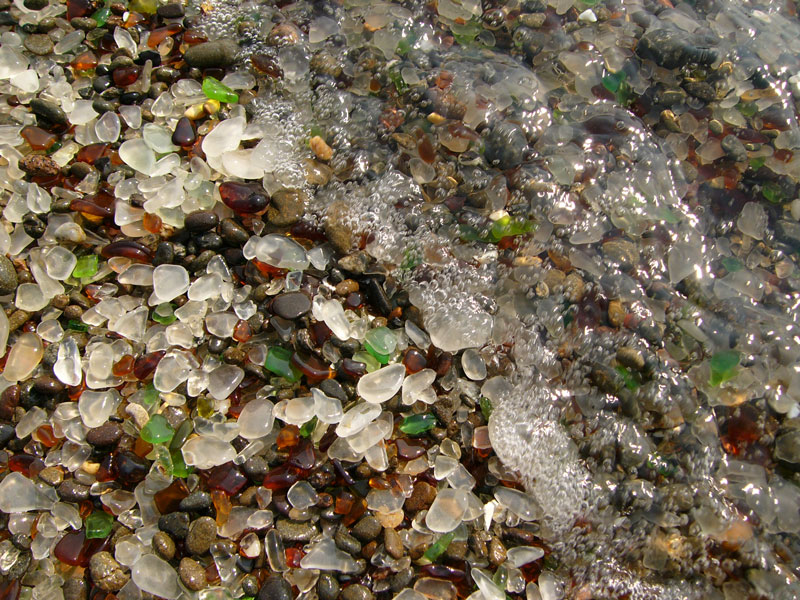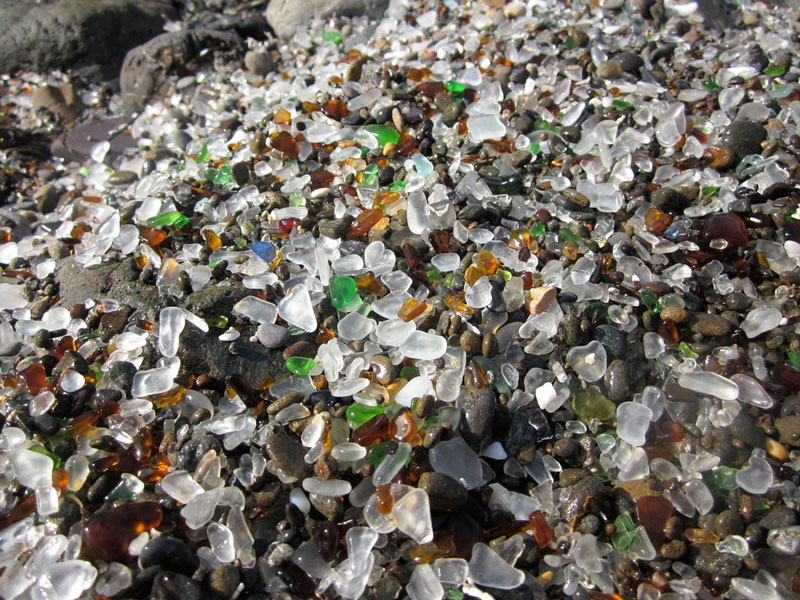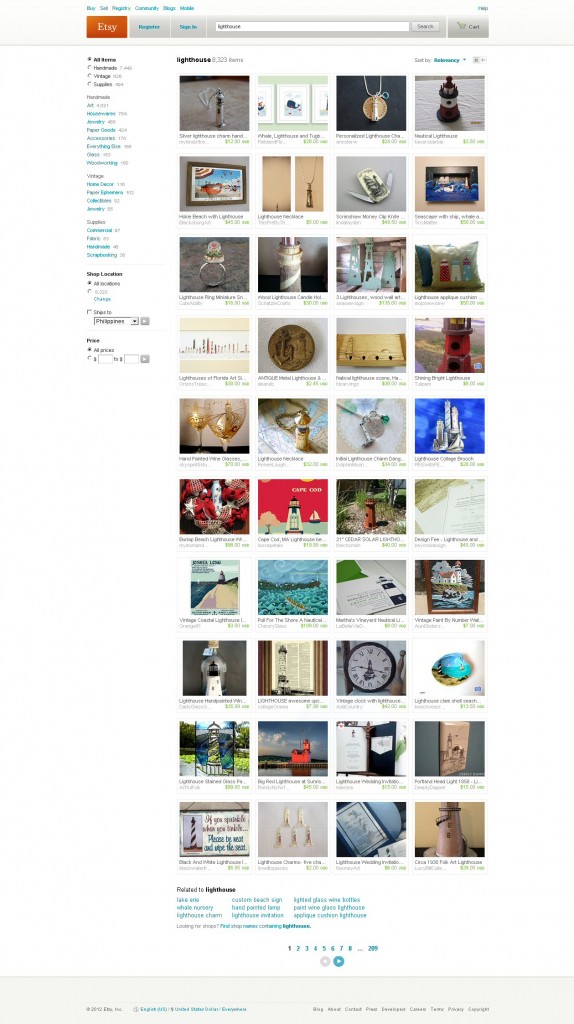
A long time ago back in 1969 on my first lighthouse at Pulteney Point, we used to recycle glass bottles by taking them out in the boat or canoe, and breaking the washed glass bottle over the side of the boat and letting the fragments settle onto the ocean floor. It was not pollution as such as most glass is 90% sand.
Have you ever seen frosted glass pieces in the beach sand? Usually many varieties of colours from the sea green pieces of broken glass from Asian fishing net floats (glass balls) to the browns and whites of everyday bottles. Usually the bottle is thrown in the sea from land, thrown overboard from a boat, or dumped from a garbage scow off a big city. Glass is the most recyclable of modern user items, even if it is just dumped in the ocean.
The whole bottle can be returned for refilling, the broken ones can be melted down and remade into new bottles. But the sea does it differently. With the pounding of the waves on a beach, each piece of a broken glass is ground down, rounded off, and frosted by the action of sand moved by the waves. Another name for these polished glass shards is mermaid’s tears.
If you are lucky you can find every colour, with red and blue harder to find. At the end of this article I will give you a way to make your own sea glass. It is very beautiful as a floor in an aquarium, used to support candles, make sun catchers – uses are endless.
What brought this story to mind was this news article:
The Glass Beach in California – January 13, 2013 on Twisted Sifter
glass-beach-mackerricher-park-fort-bragg-california – Photograph by Jef Poskanzer
In MacKerricher State Park, near the city of Fort Bragg in northern California, you will find a beach littered with glass. Over decades of crashing waves the glass has been smoothed and rounded, transforming the shoreline into a colourful palette of pebble-like glass and sand. . . . more
*********************************
Now, as promised, if you do not live near a beach with sea glass, you can make your own easily. My last lighthouse was on a rocky island with no beaches – hence no sea glass.
 Go to your nearest rockhound shop and purchase their cheapest rock tumbler. The one I had was two rubber barrels on two rollers run by a small electric motor (similar to photo on the left). The next item you need from the rockhound shop is their coarsest grit to rough up the glass.
Go to your nearest rockhound shop and purchase their cheapest rock tumbler. The one I had was two rubber barrels on two rollers run by a small electric motor (similar to photo on the left). The next item you need from the rockhound shop is their coarsest grit to rough up the glass.
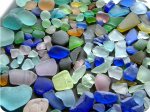
Carefully break any bottles you want to tumble, fill a tumbler barrel with the broken glass, add water and grit, close the lid securely and drop the barrel on the rails and let it run all night. Check in the morning if your glass is what you desire. If not, then tumble some more.
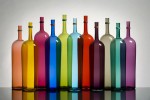 It is hard to tell real sea glass from the tumbled variety, and you have an infinite variety of coloured glass to choose from – just go to your nearest liquor store – especially in the wine section! Check out this website for more information.
It is hard to tell real sea glass from the tumbled variety, and you have an infinite variety of coloured glass to choose from – just go to your nearest liquor store – especially in the wine section! Check out this website for more information.
If you are on Facebook, check out this page from a lighthouse on the BC coast where they recycle the beach glass into ornaments such as earrings, etc.
[private]
The Glass Beach in California – January 13, 2013 on Twisted Sifter
glass-beach-mackerricher-park-fort-bragg-california – Photograph by Jef Poskanzer
In MacKerricher State Park, near the city of Fort Bragg in northern California, you will find a beach littered with glass. Over decades of crashing waves the glass has been smoothed and rounded, transforming the shoreline into a colourful palette of pebble-like glass and sand.
glass-beach-mackerricher-park-fort-bragg-california – Photograph by Molly (teeping on Flickr)
From 1906-1967 (the start date is up for debate), seaside towns were known to use the coastline as dumps, Fort Bragg was no different. After the devastation of the San Francisco earthquake the streets were filled with rubble and trash was dumped on the coast for the ocean to wash away. This of course, included plenty of glass.
glass-beach-mackerricher-park-fort-bragg-california – Photograph by John ‘K’ on Flickr
It wasn’t until 1967 when city leaders and the North Coast Water Quality Board realized what a mistake it was and sought to relocate the dump away from the ocean and clean up the shoreline. After the clean-up and more decades of crashing ocean waves; only smoothed and rounded glass mostly remained.
glass-beach-mackerricher-park-fort-bragg-california – Photograph by Jef Poskanzer
Glass Beach was purchased by California State Parks in October 2002. The Coastal Conservancy, with the City of Fort Bragg and the Mendocino Land Trust worked for over four years to assemble funding for the purchase of the 38-acre property. The Land Trust managed waste removal and clean-up, and completed botanical, archaeological and erosion control work that was required prior to purchase by State Parks. Since the Pudding Creek Trestle was completed in 2007, visitors may now walk from MacKerricher State Park to the headlands at Glass Beach connecting this highly visited “city” park to several miles of beach trails.
glass-beach-mackerricher-park-fort-bragg-california – Photograph by mamojo on Flickr
As word of this unique beach spread, more and more visitors descended onto Glass Beach. Drawn to the beautifully smoothed and rounded glass, visitors began pocketing the glass with each visit. This has greatly diminished the amount of glass on the beach. And since it is now State Park property it is a misdemeanor to remove any artifacts. While there is still glass to be found the area has been greatly depleted.
glass-beach-mackerricher-park-fort-bragg-california – Photograph by Megan (meganpru on Flickr)
In addition to searching for glass, the beach has an interesting array of tide pools to explore. Crabs, mollusks, and many aquatic plants make their homes in these ever-changing environments.
5638422480_312e6094d7_b – Photograph by Lee Rentz on Flickr
Sources
– FortBragg.com: Glass Beach – From Trash To Treasure
– Visit Mendocino: Glass Beach
– The Mendocino Land Trust: Glass Beach
– CNN: From trash to treasure
– Wikipedia: Glass Beach (Fort Bragg, California)
glass-beach-mackerricher-park-fort-bragg-california – Photograph by kara brugman on Flickr
[/private]



